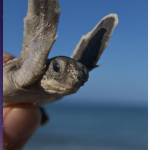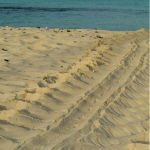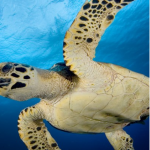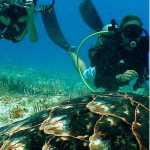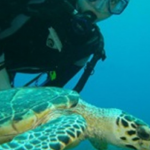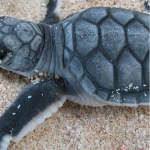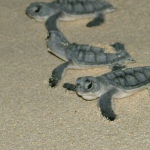Sea Turtles: Protecting the beloved symbol of the Cayman Islands


Adela Gonzales White, The Cayman Bottom Times
Grand Cayman, Cayman Islands – An encounter with a sea turtle is always high on the wish list of every visiting diver to the Cayman Islands, and they are very rarely disappointed. The sea creature recognized as the national symbol of the Cayman Islands almost always makes an appearance during a dive, sometimes more than once, fulfilling expectations like those set by Karina Erickson, a frequent guest at Sunset House and passionate sea turtle lover.
“A dive trip is not complete without a turtle on every dive, so when the divemasters ask what we want to see, my immediate reaction is turtles!” she says. “On my last trip to Grand Cayman I saw a turtle at every dive site.”
Two types of sea turtle live in Cayman waters year-round: hawksbill turtles and green turtles. Juvenile hawksbills live on the coral reefs and are often seen by scuba divers and snorkelers. Green turtles live on the seagrass beds of the lagoons inside the reef. Divemasters say they can count on spotting at least one sea turtle per dive to keep guests happy, and sometimes, as many as four turtles swim by to check out the excited divers.
“Close encounters with turtles big, or small, always put a smile on our diver’s faces,” says Red Sail Sports’ Debbie Wragg. “As divemasters we urge our divers to enjoy their turtle interactions passively – no chasing, and definitely no touching!”
Co-worker Sarah White adds that the rules of turtle protection are covered during dive briefings. “No touching, teasing or harassing – when the rules are briefed then there isn’t an issue,” she says. “Our main concern is divers wanting to touch the turtles, who are happy to hang around.”
“From young ones to old timers that weigh 400 pounds, there is nothing more special than diving with a turtle,” agrees Divetech’s Nancy Easterbrook, who has enjoyed plenty of them over the past 20 years. “They are not fussed about divers if we stay slow and calm, and let them carry out their business as usual.”
At sea, turtles play a critical role in keeping Cayman’s reefs in balance. As sponge-eaters, hawksbills keep sponges from overwhelming slow-growing hard corals. Green turtles also help the marine environment by grazing on seagrass beds. Divemasters share this tip with divers who want to see a turtle: find a Leathery Sponge (their favorite snack) and look for a circling Angel Fish, a turtle won’t be far away.
“The turtle eats the outside skin of the sponge and the Angel Fish eats the soft center of the sponge – a perfect partnership on the reef,” says Ocean Frontiers’ Steve Broadbelt. “My personal favorites are the Loggerheads which can grow to dinosaur proportions. When they loom out of the deep towards you, it takes a moment to comprehend what you are about to cross paths with.”
Since 2000 the Cayman Islands Department of Environment (DOE) has been capturing, tagging, and releasing turtles in Cayman waters to determine population size, migration patterns, growth rates, habitat use and diving behavior. Data collected with time depth recorders and acoustic tags shows that hawksbill and green turtles dive deeply on the Cayman wall, sometimes as deep as 300 ft. By using the turtles’ DNA as a kind of genetic bar-code, DOE has also discovered that young hawksbill turtles in Cayman hatched on beaches in Central America, Mexico, and the Eastern Caribbean. This means young turtles have travelled hundreds or thousands of miles by the time they reach Cayman, critical information in protecting the migrating sea turtles.
“We have discovered that Cayman hawksbills grow slowly and may live in Cayman waters for over 15 years, so they benefit from our protection during this vulnerable period in order to survive to adulthood,” says Dr. Janice Blumenthal, DOE Research Officer. “Juvenile hawksbills from across the Caribbean use our waters as a nursery habitat – but as they near maturity, they seem to leave, bound for faraway foraging grounds.”
Turtles are iconic in the Cayman Islands, and they have played a significant role in its history. During sea turtle nesting season, May – November, the local community’s focus turns to protecting the beloved creatures. DOE manages an effective turtle-nesting beach monitoring program that raises awareness and educates the public on what needs to be done to protect them.
Historically, four types of sea turtles were found in Cayman waters – green, loggerhead, hawksbill and leatherback turtles. It is believed at one time millions of green turtles nested here, the largest number in the Atlantic. Christopher Columbus, who discovered the islands in 1503, called them “Las Tortugas” because of the abundant sea turtles. Commercial harvesting decimated Cayman’s turtle populations to the point of extinction, but they have gradually made a comeback. In 1998, the DOE began surveying beaches to identify turtle nests and document nesting trends.
“The first years of monitoring showed that leatherback nesting was locally extinct, and likely lost to us forever, but extremely small numbers of green, loggerhead, and hawksbill turtles persisted,” says Dr. Blumenthal. “Since that time, hawksbill nesting has continued to hover at the edge of extinction, but loggerhead and green turtle populations have begun to show signs of recovery – increasing from less than 30 nests when DOE monitoring began in 1998 to more than 300 nests this year.” Dr. Blumenthal says DOE was encouraged to document a number of hawksbill turtle nests this year, but they have yet to see leatherbacks make a return to Cayman’s beaches. While turtle populations on reefs are thriving and nesting sea turtles have made a comeback in Cayman, they still face many threats.
Dive operators and beachfront hotels are at the forefront of both land and sea conservation efforts. On the beach, development threatens nesting turtles because light pollution disorients baby turtles – they often end up on dangerous roads instead of the sea. Many beachfront hotels and other developments turn off lights on the beach during the summer, and the DOE promotes the use of “turtle friendly lighting” designed to meet the needs of property owners without impacting nesting or hatching turtles. Because more properties are participating in protecting turtle nests and improving survival chances for the hatchlings, there are increased opportunities for low-season ecotourism. When nests start hatching, visitors lucky enough to witness the event cheer the hatchlings on as they begin their dangerous journey to the sea. Mysteriously, female turtles who survive into adulthood will someday return to nest on the same beach where they were born.
In the ocean, the biggest threat to turtles is trash – particularly entanglement in discarded fishing line. Dive operators play a key role in protecting turtles on reefs by regularly collecting fishing lines during dives and organizing reef cleanups. On Little Cayman, the Southern Cross Club organizes two island-wide beach clean-ups in advance of nesting season to help the turtles, and then they encourage resort staff, guests and residents to walk the beaches to find and monitor nests.
“With so many nests here on Little Cayman, we feel it is essential for the whole community to come together to support this project, and together, do all we can to protect our turtles,” says General Manager Jennifer Mills.
Dive operators have also participated in tracking turtles: “We’ve sponsored a satellite tracking device for a loggerhead sea turtle name Leonie, and more recently, supported the release of a farmed yearling green turtle named Sophie,” says Steve Broadbelt, General Manager of Ocean Frontiers. “We also report any unusual sightings, such as the rare one last year of leatherback turtles mating on the surface of the water – our dive staff spotted a female with two males fighting over her.”
Dr. Blumenthal says it is important to understand that sea turtles need protection everywhere.
“Because they are highly migratory, sea turtles face threats throughout their life-cycle – on the nesting beach (as eggs, hatchlings, and adults), in the open ocean, and on their feeding grounds here in the Cayman Islands,” she says. “Our management decisions in Cayman will affect turtle populations in other parts of the world – and our turtles are threatened by the actions of distant countries. To protect our turtles, we must remember that they are a shared Caribbean heritage.”
Karina Erickson can’t say why sea turtles are special to her, but she does love them, and this makes her want to protect them. “Fish flit back and forth across the reef, but its almost as if the turtle decides to come and swim along with you,” she says. “Turtles are friends who come greet you at the door to the ocean.”
About Us
The Cayman Bottom Times is news collaboration by five leading dive operators to promote the superb diving of the Cayman Islands, and keep the diving public informed of important developments and events. Divetech, Ocean Frontiers, Red Sail Sports and Sunset House in Grand Cayman, and the Southern Cross Club in Little Cayman, all members of the Cayman Islands Tourism Association, represent more than 100 years of solid experience in a destination that is recognized as the birthplace of recreational diving. With a unique combination of deep wall and shallow reef diving, several wrecks, and world-famous Stingray City, the Cayman Islands has cemented its place as the top diving destination in the Caribbean.
Offering diverse and wide-ranging dive programs on both Grand Cayman and Little Cayman, the members of this dive group represent the best Cayman has to offer; Divetech (www.divetech.com), Ocean Frontiers (www.oceanfrontiers.com), Red Sail Sports Grand Cayman (www.redsailcayman.com), Sunset House (www.sunsethouse.com) and the Southern Cross Club (www.southerncrossclub.com).
Web: www.cayman-bottom-time.com
Facebook: www.facebook.com/caymanbottomtimes

